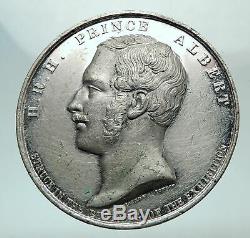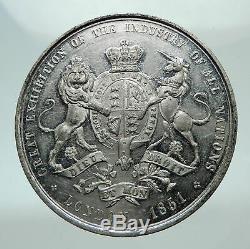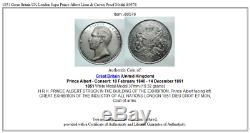1851 Great Britain UK London Expo Prince Albert Lions & Crown Proof Medal i80576





Item: i80576 Authentic Coin of. (United Kingdom) Prince Albert - Consort: 10 February 1840 - 14 December 1861 1851 White Metal Medal 37mm (19.32 grams) H. PRINCE ALBERT STRUCK IN THE BUILDING OF THE EXHIBITION, Prince Albert facing left.
GREAT EXHIBITION OF THE INDUSTRY OF ALL NATIONS LONDON 1851 DIEU DROIT ET MON, Coat-of-arms. Prince Albert of Saxe-Coburg and Gotha (Francis Albert Augustus Charles Emmanuel; 26 August 1819 - 14 December 1861) was the husband of Queen Victoria of the United Kingdom of Great Britain and Ireland.
Born in the Saxon duchy of Saxe-Coburg-Saalfeld to a family connected to many of Europe's ruling monarchs, at the age of 20 Albert married his cousin, Victoria; they had nine children. Initially he felt constrained by his role of prince consort, which did not afford him power or responsibilities. He gradually developed a reputation for supporting public causes, such as educational reform and the abolition of slavery worldwide, and was entrusted with running the Queen's household, office and estates. He was heavily involved with the organisation of the Great Exhibition of 1851, which was a resounding success.Victoria came to depend more and more on Albert's support and guidance. He aided the development of Britain's constitutional monarchy by persuading his wife to be less partisan in her dealings with Parliament-although he actively disagreed with the interventionist foreign policy pursued during Lord Palmerston's tenure as Foreign Secretary.
Albert died at the relatively young age of 42. Victoria was so devastated at the loss of her husband that she entered into a deep state of mourning and wore black for the rest of her life.
On her death in 1901, their eldest son succeeded as Edward VII, the first British monarch of the House of Saxe-Coburg and Gotha, named after the ducal house to which Albert belonged. Albert was born at Schloss Rosenau, near Coburg, Germany, the second son of Ernest III, Duke of Saxe-Coburg-Saalfeld, and his first wife, Louise of Saxe-Gotha-Altenburg. Albert's future wife, Victoria, was born earlier in the same year with the assistance of the same midwife, Charlotte von Siebold. Albert was baptised into the Lutheran Evangelical Church on 19 September 1819 in the Marble Hall at Schloss Rosenau with water taken from the local river, the Itz.
His godparents were his paternal grandmother, the Dowager Duchess of Saxe-Coburg-Saalfeld; his maternal grandfather, the Duke of Saxe-Gotha-Altenburg; the Emperor of Austria; the Duke of Teschen; and Emanuel, Count of Mensdorff-Pouilly. In 1825, Albert's great-uncle, Frederick IV, Duke of Saxe-Gotha-Altenburg, died. His death led to a realignment of Saxon duchies the following year and Albert's father became the first reigning duke of Saxe-Coburg and Gotha. Albert and his elder brother, Ernest, spent their youth in a close companionship marred by their parents' turbulent marriage and eventual separation and divorce. After their mother was exiled from court in 1824, she married her lover, Alexander von Hanstein, Count of Polzig and Beiersdorf. She presumably never saw her children again, and died of cancer at the age of 30 in 1831. The following year, their father married his niece, his sons' cousin Princess Marie of Württemberg; their marriage was not close, however, and Marie had little-if any-impact on her stepchildren's lives. The brothers were educated privately at home by Christoph Florschütz and later studied in Brussels, where Adolphe Quetelet was one of their tutors. Like many other German princes, Albert attended the University of Bonn, where he studied law, political economy, philosophy and the history of art. He played music and excelled at sport, especially fencing and riding. His tutors at Bonn included the philosopher Fichte and the poet Schlegel. The idea of marriage between Albert and his cousin, Victoria, was first documented in an 1821 letter from his paternal grandmother, the Dowager Duchess of Saxe-Coburg-Saalfeld, who said that he was "the pendant to the pretty cousin".By 1836, this idea had also arisen in the mind of their ambitious uncle Leopold, who had been King of the Belgians since 1831. At this time, Victoria was the heir presumptive to the British throne. Her father, Prince Edward, Duke of Kent and Strathearn, the fourth son of King George III, had died when she was a baby, and her elderly uncle, King William IV, had no legitimate children. Her mother, the Duchess of Kent, was the sister of both Albert's father-the Duke of Saxe-Coburg and Gotha-and King Leopold.
Leopold arranged for his sister, Victoria's mother, to invite the Duke of Saxe-Coburg and Gotha and his two sons to visit her in May 1836, with the purpose of meeting Victoria. William IV, however, disapproved of any match with the Coburgs, and instead favoured the suit of Prince Alexander, second son of the Prince of Orange. Victoria was well aware of the various matrimonial plans and critically appraised a parade of eligible princes.
She wrote, [Albert] is extremely handsome; his hair is about the same colour as mine; his eyes are large and blue, and he has a beautiful nose and a very sweet mouth with fine teeth; but the charm of his countenance is his expression, which is most delightful. " Alexander, on the other hand, she described as "very plain. Victoria wrote to her uncle Leopold to thank him for the prospect of great happiness you have contributed to give me, in the person of dear Albert... He possesses every quality that could be desired to render me perfectly happy. Although the parties did not undertake a formal engagement, both the family and their retainers widely assumed that the match would take place.
Victoria came to the throne aged eighteen on 20 June 1837. Her letters of the time show interest in Albert's education for the role he would have to play, although she resisted attempts to rush her into marriage. In the winter of 1838-39, the prince visited Italy, accompanied by the Coburg family's confidential adviser, Baron Stockmar.
Albert and Victoria felt mutual affection and the Queen proposed to him on 15 October 1839. Victoria's intention to marry was declared formally to the Privy Council on 23 November, and the couple married on 10 February 1840 at the Chapel Royal, St James's Palace. Just before the marriage, Albert was naturalised by Act of Parliament, and granted the style of Royal Highness by an Order in Council.Initially Albert was not popular with the British public; he was perceived to be from an impoverished and undistinguished minor state, barely larger than a small English county. The British Prime Minister, Lord Melbourne, advised the Queen against granting her husband the title of "King Consort"; Parliament also objected to Albert being created a peer-partly because of anti-German sentiment and a desire to exclude Albert from any political role. Albert's religious views provided a small amount of controversy when the marriage was debated in Parliament: although as a member of the Lutheran Evangelical Church Albert was a Protestant, the non-Episcopal nature of his church was considered worrisome.
Of greater concern, however, was that some of Albert's family were Roman Catholic. Melbourne led a minority government and the opposition took advantage of the marriage to weaken his position further. Albert claimed that he had no need of a British peerage, writing: It would almost be a step downwards, for as a Duke of Saxony, I feel myself much higher than a Duke of York or Kent. " For the next seventeen years, Albert was formally titled "HRH Prince Albert until, on 25 June 1857, Victoria formally granted him the title Prince Consort. The Queen's household was run by her former governess, Baroness Lehzen.
Albert referred to her as the "House Dragon", and manoeuvred to dislodge the Baroness from her position. Within two months of the marriage, Victoria was pregnant. Albert started to take on public roles; he became President of the Society for the Extinction of Slavery (which was still legal in the southern United States and the colonies of France); and helped Victoria privately with her government paperwork. In June 1840, while on a public carriage ride, Albert and the pregnant Victoria were shot at by Edward Oxford, who was later judged insane. Neither Albert nor Victoria was hurt and Albert was praised in the newspapers for his courage and coolness during the attack. Albert was gaining public support as well as political influence, which showed itself practically when, in August, Parliament passed the Regency Act 1840 to designate him regent in the event of Victoria's death before their child reached the age of majority. Their first child, Victoria, named after her mother, was born in November. Eight other children would follow over the next seventeen years. All nine children survived to adulthood, which was remarkable for the era and which biographer Hermione Hobhouse credited to Albert's "enlightened influence" on the healthy running of the nursery.In early 1841, he successfully removed the nursery from Lehzen's pervasive control, and in September 1842, Lehzen left Britain permanently-much to Albert's relief. After the 1841 general election, Melbourne was replaced as Prime Minister by Sir Robert Peel, who appointed Albert as chairman of the Royal Commission in charge of redecorating the new Palace of Westminster.
The Palace had burned down seven years before, and was being rebuilt. As a patron and purchaser of pictures and sculpture, the commission was set up to promote the fine arts in Britain. The commission's work was slow, and the architect, Charles Barry, took many decisions out of the commissioners' hands by decorating rooms with ornate furnishings that were treated as part of the architecture. Albert was more successful as a private patron and collector. Albert and Victoria were shot at again on both 29 and 30 May 1842, but were unhurt. The culprit, John Francis, was detained and condemned to death, although he was later reprieved. Some of their early unpopularity came about because of their stiffness and adherence to protocol in public, though in private the couple were more easy-going. Over the next few years a house modelled in the style of an Italianate villa was built to the designs of Albert and Thomas Cubitt.Albert laid out the grounds, and improved the estate and farm. Albert managed and improved the other royal estates; his model farm at Windsor was admired by his biographers, and under his stewardship the revenues of the Duchy of Cornwall-the hereditary property of the Prince of Wales-steadily increased.
Unlike many landowners who approved of child labour and opposed Peel's repeal of the Corn Laws, Albert supported moves to raise working ages and free up trade. In 1846, Albert was rebuked by Lord George Bentinck when he attended the debate on the Corn Laws in the House of Commons to give tacit support to Peel. During Peel's premiership, Albert's authority behind, or beside, the throne became more apparent. He had access to all the Queen's papers, was drafting her correspondence and was present when she met her ministers, or even saw them alone in her absence. The clerk of the Privy Council, Charles Greville, wrote of him: He is King to all intents and purposes.
Great Britain , also known as Britain , is an island in the North Atlantic off the north-west coast of continental Europe. With an area of 209,331 km. (80,823 sq mi), it is the largest island in Europe and the ninth-largest in the world. In 2011 the island had a population of about 61 million people, making it the third-most populous island in the world, after Java in Indonesia and Honshu in Japan. The island is the largest in the British Isles archipelago, which also includes the island of Ireland to its west and over 1,000 smaller surrounding islands.
The island is dominated by an oceanic climate with quite narrow temperature differences between seasons. Politically, the island is part of the United Kingdom of Great Britain and Northern Ireland, constituting most of its territory: most of England, Scotland, and Wales are on the island, with their respective capital cities, London, Edinburgh, and Cardiff. The term Great Britain often extends to include surrounding islands that form part of England, Scotland, and Wales. A single Kingdom of Great Britain resulted from the Union of Scotland and England (which already comprised the present-day countries of England and Wales) in 1707. More than a hundred years before, in 1603, King James VI, King of Scots, had inherited the throne of England, but it was not until 1707 that the Parliaments of the two countries agreed to form a unified state. In 1801, Great Britain united with the neighboring Kingdom of Ireland, forming the United Kingdom of Great Britain and Ireland, which was renamed the United Kingdom of Great Britain and Northern Ireland after the Irish Free State seceded in 1922. World-renowned expert numismatist, enthusiast, author and dealer in authentic ancient Greek, ancient Roman, ancient Byzantine, world coins & more.Ilya Zlobin is an independent individual who has a passion for coin collecting, research and understanding the importance of the historical context and significance all coins and objects represent. Send me a message about this and I can update your invoice should you want this method. Getting your order to you, quickly and securely is a top priority and is taken seriously here. Great care is taken in packaging and mailing every item securely and quickly.
What is a certificate of authenticity and what guarantees do you give that the item is authentic? You will be very happy with what you get with the COA; a professional presentation of the coin, with all of the relevant information and a picture of the coin you saw in the listing.Additionally, the coin is inside it's own protective coin flip (holder), with a 2x2 inch description of the coin matching the individual number on the COA. Whether your goal is to collect or give the item as a gift, coins presented like this could be more prized and valued higher than items that were not given such care and attention to. When should I leave feedback? Please don't leave any negative feedbacks, as it happens sometimes that people rush to leave feedback before letting sufficient time for their order to arrive. The matter of fact is that any issues can be resolved, as reputation is most important to me.
My goal is to provide superior products and quality of service. How and where do I learn more about collecting ancient coins?Visit the Guide on How to Use My Store. For on an overview about using my store, with additional information and links to all other parts of my store which may include educational information on topics you are looking for.
The item "1851 Great Britain UK London Expo Prince Albert Lions & Crown Proof Medal i80576" is in sale since Monday, November 4, 2019. This item is in the category "Coins & Paper Money\Exonumia\Medals". The seller is "highrating_lowprice" and is located in Rego Park, New York. This item can be shipped worldwide.


